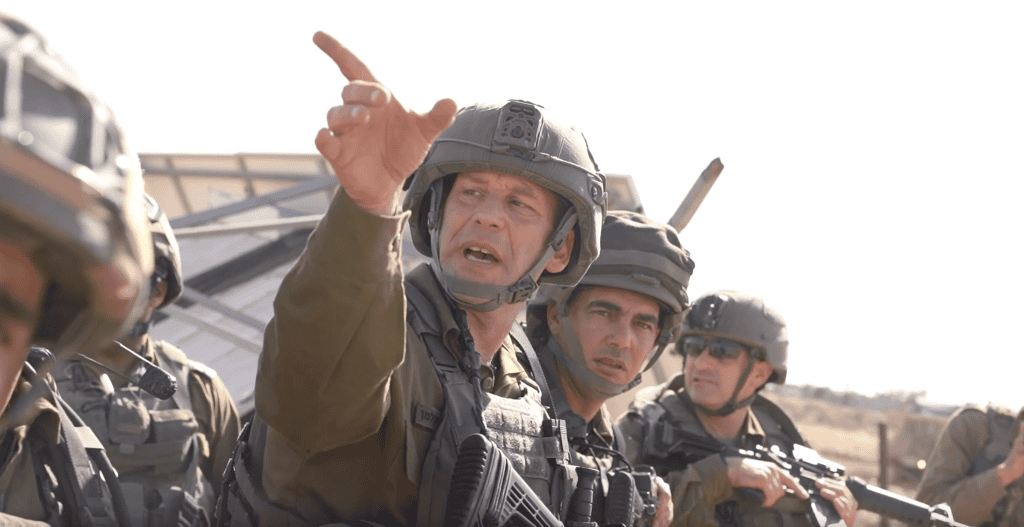
Israel expanded ground operations in Gaza on Monday, October 30. Israeli forces carried out 600 strikes on targets in the last several days, according to a statement from the IDF. With tanks, combat engineers and infantry now on the ground in the Gaza strip operating to develop their maneuvers in several sectors, the ground forces are able to help direct air force strikes.
This is taking its toll on Hamas, the IDF said. In one incident, ground forces helped the air force target a building with an estimated 20 Hamas fighters inside.
Israel is being vague about where its operations are developing. Last week the IDF carried out two raids with armored vehicles and bulldozers to clear berms on the border. The raids took place in the north and central Gaza strip. The Israeli army has put out photos of operations, showing vehicles moving through dunes and sandy areas near the water and also in agricultural areas that are on the outskirts of Gaza City. Gaza City and its environs are so large that it occupies most of the width of the strip, forming an urban buffer between the very northern end of the strip and an open area in the center. Arabic media has suggested Israel may be trying to cut the Gaza Strip in two by moving forces to cut a key road that links Gaza City to the south through this “soft” central area.
“Over the past day, we have expanded ground activities, with additional forces entering the Gaza Strip including Infantry, Armored Corps, Combat Engineering and Artillery Corps. Through integrated strikes of the Ground Forces and the IAF, dozens of terrorists were eliminated last night who had barricaded themselves in buildings and attempted to attack the forces that were moving in their direction,” IDF spokesperson Read Admiral Daniel Hagari said on Monday.
Israel’s commander of Southern Command Maj. Gen. Yaron Finkelman also assessed the situation meeting with forces on the ground, the IDF said. This came after Israel Chief of Staff Herzi Halevi also met with members of the artillery on Sunday. He has been doing the rounds of various units.
The IDF says that ground forces helped aircraft and UAVs carry out 150 attacks over the last several days. This is part of the larger air campaign which has been striking around 200 targets a night. From the city of Sderot, where I went on Saturday, October 28, the sound of the airstrikes, tank fire and artillery fire could be heard non-stop after sunset. This has been the usual pattern, with increased tempo overnight. Sderot is around a mile from the border. There have been clashes near the border, including Hamas members who tried to exit a tunnel near Erez, where a road crosses the border, and they were eliminated, the IDF said. In addition, there have been clashes near the beach, south of Zikim. There are all areas Hamas attacked on October 7.
The IDF pointed to the close work of ground force commanders in working with the air force in the last several days. “As part of the preparations for the expansion of combat, and with the understanding that one of the Air Force’s missions is to provide an air ‘umbrella’ for the forces, squadron commanders teamed up with infantry unit commanders, and carried out joint training together in a variety of formats,” the IDF said.
Now the training is paying off, as the IDF says this enables the IDF to “close circles in a short time on targets in real time.” This attempt to close sensor to shooter circles quickly was part of the IDF’s digitization and Momentum plan that has been a focus of new technology and training over the last three years. While much of the technology appeared to not be able to bring force to bear quickly on October 7, during the massive Hamas surprise attack that led to 300 IDF soldiers killed and more than 1,000 civilians killed and 230 taken hostage; now the situation appears to be changing.
Israel also continued to carry out precision strikes on Hamas commanders. The IDF said it killed two key personnel in Hamas Tafah battalion. Many IDF strikes have targeted Hamas commanders in the three weeks of war. Thousands of munitions have been used in these strikes.
Hamas has also launched 8,000 rockets at Israel. On Monday, rockets targeted Jerusalem and areas around Tel Aviv, showing Hamas continues to have a long-range rocket capability. However, its volume of fire is greatly reduced from the first weeks of the war.
Tensions continued along Israel’s northern border, where Israel carried out strikes in Syria. Israel Defense Minister Yoav Gallant warned Hezbollah against threats to Israel. Israel is also keeping a close eye on the West Bank, where Israel used the air force to carry out strikes in Jenin on Sunday night. Israel has now lost 315 soldiers in three weeks of war. Three more casualties were announced Sunday, and one soldier was buried in Jerusalem. He was killed when his tank overturned in the north. Israel also released one hostage from Gaza, a soldier in an observation unit abducted by Hamas on October 7.







